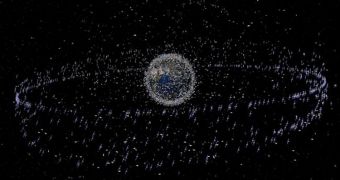According to analysts, we may be able to keep the cloud of space junk currently clogging Earth's orbits from getting larger for at least 200 years or so. All we have to do is remove about 5 large pieces of debris every year. This objective is not too ambitious, and could be achieved with small investments.
The main issue with space junk is not necessarily that there are more than 500,000 pieces of it out there. The most important aspect is that there are also thousands of very large pieces, such as entire satellites, spent rocket stages and so on.
As demonstrated by a 2009 collision between a Russian and an American satellite, interactions between these large components are the thing to worry about the most. Each of these collisions has the potential to generate thousands of new pieces of debris, further exacerbating the problem.
By developing a way of removing at least the largest of the debris, we may be able to prevent the cloud of junk from growing. Additional efforts could even lead to a reduction, analysts say, quoted by Space.
“Orbital debris is a serious issue, but at the same time, the sky is not falling,” NASA Orbital Debris Program Office expert J.-C. Liou explained. He made the announcement on February 22, in front of experts gathered at the Future In-Space Operations working group, in Houston.
Experts says that the most visible results will be achieved if we use both active and passive clean-up methods. “I think we can continue to manage the current environment for some time – maybe 10 years or 20 years – before we have to consider debris removal to better preserve the environment for future generations,” Liou said.
There are currently more than 1,000 operational satellites in Earth's orbit, which are under direct threat from 22,000 of the largest pieces of space debris. These are the ones that are larger than a softball. The International Space Station is also at great risk.
“The typical impact velocity in low-Earth orbit is about 10 kilometers per second [22,300 mph], and because of that, even a sub-millimeter debris could be a problem for human spaceflight and for robotic missions,” the NASA expert adds.
What is beginning to become increasingly clear for all experts is that some measures to deal with this problem will have to be taken as soon as possible. Research teams around the world are already working on various orbital clean-up approaches, and some of them are quite promising.

 14 DAY TRIAL //
14 DAY TRIAL //